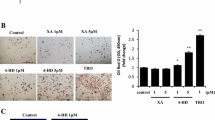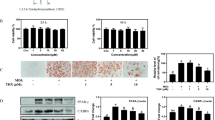Abstract
Adipose tissue is an endocrine organ and its endocrine function is closely associated with type 2 diabetes mellitus. Valeriana officinalis (Valerian) exerts some physiological effects; however, its influence on adipocytes remains unclear. We investigated the effect of methanolic Valerian root extract (Vale) on 3T3-L1 adipocytes. Vale (1, 10, and 100 μg/mL) dose-dependently promoted adipocyte differentiation with increasing lipid accumulation. In addition, Vale significantly increased the mRNA levels in genes associated with adipocyte differentiation, including peroxisome proliferator-activated receptor γ (PPARγ), CCAAT/enhancer-binding protein α , and adipocyte protein 2, in dose-dependent manner. Vale also significantly enhanced mRNA and protein levels in adiponectin. A PPARγ antagonist assay and a PPARγ binding assay revealed that Vale-induced increased adipocyte differentiation and adiponectin production were partly associated with direct binding to PPARγ. Valerenic acid, a characteristic component in Valerian, also demonstrated the ability to induce adipocyte differentiation and adiponectin secretion, suggesting that it is one of the functional components in Vale.




Similar content being viewed by others
Abbreviations
- BADGE:
-
bisphenol a diglycidyl ether
- C/EBPα:
-
CCAAT/enhancer-binding protein α
- DMEM:
-
Dulbecco’s modified Eagle’s medium (high glucose) with L-glutamine, phenol red, and sodium pyruvate
- DMSO:
-
dimethyl sulfoxide
- MTT:
-
3-(4,5-dimethylthiazol-2-yl)-2,5-diphenyltetrazolium bromide
- PPARα:
-
peroxisome proliferator-activated receptor α
- PPARγ:
-
peroxisome proliferator-activated receptor γ
- Rosi:
-
Rosiglitazone
- SE:
-
standard error
- Vale:
-
methanolic Valerian root extract
- Valerian:
-
Valeriana officinalis
References
Beidokhti MN, Jäger AK (2017) Review of antidiabetic fruits, vegetables, beverages, oils and spices commonly consumed in the diet. J Ethnopharmacol 201:26–41
Coelho M, Oliveira T, Fernandes R (2013) Biochemistry of adipose tissue: an endocrine organ. Arch Med Sci 9:191–200
Kadowaki T, Yamauchi T (2011) Adiponectin receptor signaling: a new layer to the current model. Cell Metab 13:123–124
Kadowaki T, Yamauchi T (2005) Adiponectin and adiponectin receptors. Endocr Rev 26:439–451
Havel PJ (2004) Update on adipocyte hormones: regulation of energy balance and carbohydrate/lipid metabolism. Diabetes 53:S143–S151
Kubota N, Yamauchi T, Tobe K, Kadowaki T (2006) Adiponectin-dependent and -independent pathways in insulin-sensitizing and antidiabetic actions of thiazolidinediones. Diabetes 55:S32–S38
Scheen AJ (2001) Thiazolidinediones and liver toxicity. Diabetes Metab 27:305–313
Shah P, Mudaliar S (2010) Pioglitazone: side effect and safety profile. Expert Opin Drug Saf 9:347–354
Atanasov AG, Wang JN, Gu SP, Bu J, Kramer MP, Baumgartner L, Fakhrudin N, Ladurner A, Malainer C, Vuorinen A, Noha SM, Schwaiger S, Rollinger JM, Schuster D, Stuppner H, Dirsch VM, Heiss EH (2013) Honokiol: a non-adipogenic PPARγ agonist from nature. Biochim Biophys Acta 1830:4813–4819
Lee W, Ham J, Kwon HC, Kim YK, Kim SN (2013) Anti-diabetic effect of amorphastilbol through PPARα/γ dual activation in db/db mice. Biochem Biophys Res Commun 432:73–79
National Toxicology Program (2009) Chemical Information Review Document for Valerian (Valeriana officinalis L.) [CAS No. 8057-49-6] and Oils [CAS No. 8008-88-6]. Available from the NTP web site at Internet address: https://ntp.niehs.nih.gov/ntp/noms/support_docs/valerian_nov2009_508.pdf
Houghton PJ (1999) The scientific basis for the reputed activity of valerian. J Pharm Pharmacol 51:505–512
Rosen ED (2002) The molecular control of adipogenesis, with special reference to lymphatic pathology. Ann N Y Acad Sci 979:143–158 discussion 188-196
Kralisch S, Fasshauer M (2013) Adipocyte fatty acid binding protein: a novel adipokine involved in the pathogenesis of metabolic and vascular disease? Diabetologia 56:10–21
Spranger J, Kroke A, Möhlig M, Bergmann MM, Ristow M, Boeing H, Pfeiffer AFH (2003) Adiponectin and protection against type 2 diabetes mellitus. Lancet 361:226–228
Iwaki M, Matsuda M, Maeda N, Funahashi T, Matsuzawa Y, Makishima M, Shimomura I (2003) Induction of adiponectin, a fat-derived antidiabetic and antiatherogenic factor, by nuclear receptors. Diabetes 52:1655–1663
Yamamoto J, Yamane T, Oishi Y, Shimizu M, Tadaishi M, Kobayashi-Hattori K (2015) Chrysanthemum promotes adipocyte differentiation, adiponectin secretion and glucose uptake. Am J Chin Med 43:255–267
Raciti GA, Fiory F, Campitelli M, Desiderio A, Spinelli R, Longo M, Nigro C, Pepe G, Sommella E, Campiglia P, Formisano P, Beguinot F, Miele C (2018) Citrus aurantium L. dry extracts promote C/ebpβ expression and improve adipocyte differentiation in 3T3-L1 cells. PLoS One 13:e0193704
Saito T, Abe D, Sekiya K (2008) Sakuranetin induces adipogenesis of 3T3-L1 cells through enhanced expression of PPARγ2. Biochem Biophys Res Commun 372:835–839
Yi W, Shi J, Zhao G, Zhou XE, Suino-Powell K, Melcher K, Xu HE (2017) Identification of a novel selective PPARγ ligand with a unique binding mode and improved therapeutic profile in vitro. Sci Rep 27:41487
Jung HY, Yoo DY, Nam SM, Kim JW, Choi JH, Yoo M, Lee S, Yoon YS, Hwang IK (2015) Valerenic acid protects against physical and psychological stress by reducing the turnover of serotonin and norepinephrine in mouse hippocampus-amygdala region. J Med Food 18:1333–1339
Nam SM, Choi JH, Yoo DY, Kim W, Jung HY, Kim JW, Kang SY, Park J, Kim DW, Kim WJ, Yoon YS, Hwang IK (2013) Valerian officinalis extract and its main component, valerenic acid, ameliorate D-galactose-induced reductions in memory, cell proliferation, and neuroblast differentiation by reducing corticosterone levels and lipid peroxidation. Exp Gerontol 48:1369–1377
Hendriks H, Bos R, Woerdenbag HJ, Koster AS (1985) Central nervous depressant activity of valerenic acid in the mouse. Planta Med 51:28–31
Ghafari S, Esmaeili S, Aref H, Naghibi F, Mosaddegh M (2009) Qualitative and quantitative analysis of some brands of valerian pharmaceutical products. Stud Ethno Med 3:61–64
Fernández S, Wasowski C, Paladini AC, Marder M (2004) Sedative and sleep-enhancing properties of linarin, a flavonoid-isolated from Valeriana officinalis. Pharmacol Biochem Behav 77:399–404
Funding
This study was partly funded by The Foundation for Dietary Scientific Research (granted to Kazuo Kobayashi-Hattori).
Author information
Authors and Affiliations
Corresponding author
Ethics declarations
Conflict of Interest
The authors declare that they have no conflict of interest.
Additional information
Publisher’s Note
Springer Nature remains neutral with regard to jurisdictional claims in published maps and institutional affiliations.
Electronic supplementary material
ESM 1
(PDF 386 kb)
Rights and permissions
About this article
Cite this article
Harada, K., Kato, Y., Takahashi, J. et al. The Effect of Methanolic Valeriana officinalis Root Extract on Adipocyte Differentiation and Adiponectin Production in 3T3-L1 Adipocytes. Plant Foods Hum Nutr 75, 103–109 (2020). https://doi.org/10.1007/s11130-019-00790-2
Published:
Issue Date:
DOI: https://doi.org/10.1007/s11130-019-00790-2




